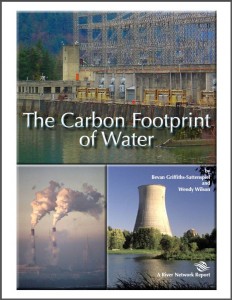How much impact does one gallon of water in your home or business have on the environment?
While working on a personal carbon footprint guidebook, I struggled to answer this question about the impact of water usage on the environment.
Most of us receive a monthly utility bill for the amount of water we use. If you heat the water, you will get charged for it in your electric bill or gas bill, so we already have that impact captured (and that’s the biggest impact of water, heating it for showers, dishwashers, laundry and cooking).
What I really wanted to know was how much energy does it take for the utility to transport the water to you, then retrieve it and process it. There are large motors and pumps involved, and the more water we consume, the more energy is required by the utilities to handle it. Seems like a simple question, but I could not find a calculator anywhere.
I found a study conducted by the River Network called, “The Carbon Footprint of Water.” I thought this report would give me exactly what I was looking for, but I still needed to do a few calculations, since I wasn’t concerned with the heating of water, just the transporting and processing of it.
Most of our bills in the US record the water usage based on number of gallons or hundred cubic feet (CCF). I needed to determine a number that could convert the number of gallons or CCF to metric tons of carbon equivalent.
Within the report, they provide the following estimates about kWh needed for each of these two tasks.
Supplying Water: “The energy intensity of municipal water supplies on a whole system basis can range from a low of 1,050 kWh/MG to a hypothetical high upwards of 36,200 kWh/MG, while a more typical range between 1,250 kWh/MG and 6,500 kWh/MG is found for most water systems.”
Treating Water: “A typical range for wastewater treatment and collection varies from 1,000 kWh/MG and 3,000 kWh/MG, with some utilities reporting energy intensities as high as 6,000 kWh/MG.”
To make things simple, I added the average kWh per million gallons (MG) for supplying water (3875 kWh/MG) to the average kWh per MG for treating water (2000 kWh/MG), to come up with 5,875 kWh/MG.
Using the EPA greenhouse gas calculator for converting kWh to metric tons of carbon dioxide equivalent, there are 4.1 metric tons per MG. Divide by one million, and we get 0.000004082 metric tons per gallon. An easier calculation is to take the number of gallons and divide by 244,956.
If you use 2,000 gallons per month, your carbon emissions for water would be 2,000/244956 = 0.008 metric tons.

If your water bill is displayed in cubic feet (CF), you will need to divide by 100, in order to get it into CCF. Once you have the amount of water in CCFs (equal to 748 gallons), you can determine the number of metric tons by multiplying by 0.00307, or you can divide by 326.
If you use 3 CCF per month, your carbon emissions would be 3/326 = 0.009 metric tons.
Overall, water supply and treatment do not have a huge impact on greenhouse gas emissions. However, we are quickly running out of freshwater supplies, and we are not replenishing our underground aquifers properly. This is why conserving water is so important. In addition, heating the water costs you money, and that does have a large impact on emissions, so look for ways to reduce your shower times and minimize hot water use while cooking and cleaning.
Have you seen any other estimates of carbon per gallon of water used? If so, let us know.






